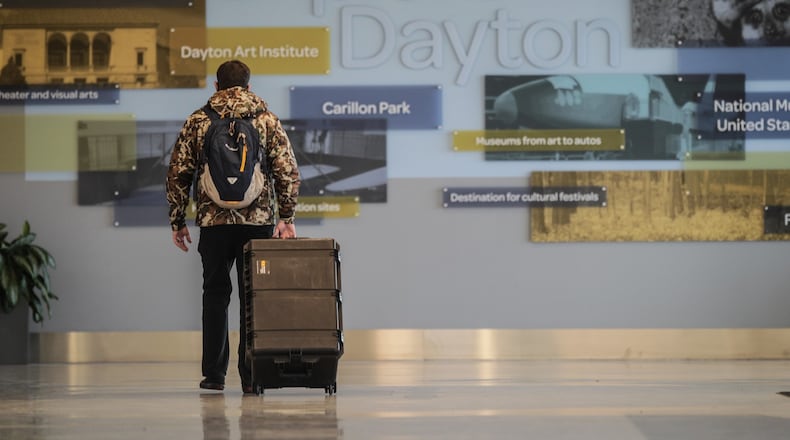That colossal drop mirrors one experienced by the industry as a whole nationwide, with U.S. airlines reporting 27 million originating passengers in the third quarter of 2020, down from 86 million passengers a year earlier, a 68.6 percent drop, according to the most recent data available from the Bureau of Transportation Statistics (BTS).
The airline industry right now is seeing “a bit of a rebound” at the start of 2021, according to aviation expert Jay Ratliff.
A typical day, the TSA screens 2 million people nationwide and as many as 2.5 million during November and December, Ratliff told this news outlet. Travel numbers during the pandemic dropped as low as 87,000 people flying on one day last April, a 95 percent decline.
“That was the bottom,” Ratliff said. “We use that as the scale moving forward.”
On Thursday, the TSA screened approximately 750,000 people, he said, which doesn’t bring daily air travel anywhere near the halfway mark. “We are seeing a recovery, but we’re still 65 percent below last year’s numbers,” Ratliff said. “When is it going to turn around?”
When COVID first struck early last year, the airline industry believed blocking middle seats, creating distance between passengers on planes and showing people how it sanitized aircrafts was going to be enough to have people come back in larger numbers, he said.
It didn’t work.
Then the airline industry started to tout how “aggressive ventilation systems” on board airplanes with HEPA filters used in hospitals would helped increase the rate of those booking a flight, Ratliff said. When that didn’t work either, the industry shifted to a mandatory masking policy, which didn’t have the major impact for which airlines had hoped.
“We saw a little bit of an increase over Thanksgiving, a little bit of an increase toward the end of the year, but that’s as far as it went and then we dropped right back to this 65 percent below where we were at,” Ratliff said.
That’s mean double digit losses in the millions daily for airlines, some of which haven’t seen losses in decades.
“The question about ‘When is it going to recover?” is one that the airlines simply don’t have an answer for,” Ratliff said. “They’re hopeful that once the vaccine is out there, people will be taking it and people will be traveling.”
The drop-off in the amount of originating passengers is having an effect on the overall financing, staffing and daily operations of airports nationwide, Ratliff said.
“They make money through the parking revenues, they make money through the enplanement ... and also on landing fees, so if you have fewer flights, fewer passengers, fewer people parking, yeah, airports are going to be hammered just as much as everyone else,” he said.
Budgets, staffing and concessions all needed to be adjusted at Dayton International Airport to align with the decrease in passenger traffic, according to Linda Hughes, its air service and public relations administrator.
“Airport staffing was adjusted by voluntary separation and retirements,” Hughes said. “Shops and restaurants have been scaled back to align with the number of passengers traveling through the airport. The CARES Act funding received earlier last year also helped us to meet our debt service obligations.”
Leisure travel is the largest traffic the Dayton airport is seeing, Hughes said. Prior to COVID-19, the airport saw more business travelers than leisure travelers, but many companies have suspended their business travel due to the pandemic.
“As companies become more comfortable with COVID numbers, and state restrictions decreasing throughout the country, then business travel will begin to rebound,” she said.
Some officials in Washington, D.C. have recently pondered if domestic travelers should be held to the same rigorous standards recently imposed on international travelers entering the United States: having to prove a negative COVID-19 test at least 72 hours prior to a date of travel or documentation that a traveler has had the coronavirus and recovered.
“The airlines are like ‘Please, don’t you dare even think that because the last thing we want is fewer people flying because of the hoops that they’d have to jump through,” he said.
Airfare from Dayton International Airport and airports nationwide increased only slightly during the third quarter of 2020 from the quarter before, the lowest point on record.
The airport had average inflation-adjusted domestic fares of $278.96 for the quarter ending Sept. 30, just slightly up from $269.20 in the second quarter but still down from the same time in 2019, according to new U.S. Department of Transportation data.
In terms of airfare at the 100 largest airports, Dayton’s nearly $279 average airfare ranked the 14th most expensive airport in the country, more expensive than Cincinnati/Northern Kentucky International Airport (CVG), which ranked 81st with an average airfare of $220.
The national average fare declined to $245 in the third quarter, the lowest inflation-adjusted average quarterly air fare in the Bureau of Transportation Statistics records dating back to 1995. It marked a 6.7 percent drop from the second quarter of this year, when it was about $262, the previous low, and a 29.9 percent decline from the third quarter of 2019, when fares were $349, according to BTS.
Averages do not include frequent-flyer or “zero fares.”
BY THE NUMBERS: Dayton airport
892,414: number of passenger enplanements in 2019
337,517: number of enplanements in 2020
$278.96: average airfare for third quarter of 2020
SOURCES: Dayton International Airport, Bureau of Transportation Statistics
About the Author

